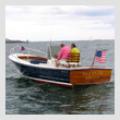Big Bash in Belfast
 Underway, a Bantry Bay gig looks crowded, but three or four crew are needed to tack each of its three sails. Courtesy Atlantic Challenge USA
Underway, a Bantry Bay gig looks crowded, but three or four crew are needed to tack each of its three sails. Courtesy Atlantic Challenge USA
Every two years from 1984 until 2018, international teams of young sailors would gather in a different country to launch unwieldy replicas of 18th century French naval longboats and compete in the Atlantic Challenge, a regatta-styled event with sailing, rowing, and skills contests designed to make participants better citizens while mastering and preserving seafaring traditions.
The event was started by two admirers of wooden boats, Apprenticeshop founder Lance Lee, here in Maine, and Bernard Cadoret, in Brittany, France. The first contest, sailed in New York, in the shadow of the Statue of Liberty by young sailors from America and France, involved a pair of boats, called Bantry Bay gigs, whose lines were taken from a French admiral’s barge the men found in a museum in Ireland. The two original gigs were built by students at the Apprenticeshop. Since then, more than 80 of the boats have been built in various countries around the world.
This summer, after a six-year pause caused by the global pandemic and world politics, the Challenge is on again, this time in Belfast, the week of July 21-28, with some 300 young sailors from a dozen or more countries taking part. It should be a lively scene—and all quite viewable from the city waterfront, said Arista Holden, Atlantic Challenge USA executive director.
And, she added, there should be a good show to watch. The 38-foot-long gigs are not easy to handle. Boats are equipped with 10 beefy oars for rowing, so sailors manning them have to work in synch with each other, something that’s not always so easily done.
And the boats have no keel, so under sail they tend to slide sideways a good deal of the time. They also have three masts for the same number of sails, flown on what’s called a dipping-lug rig. Don’t feel bad, I had to ask for an explanation too.
 In tight quarters, maneuvering can get interesting as the gigs race from mark to mark. Courtesy Atlantic Challenge USA
In tight quarters, maneuvering can get interesting as the gigs race from mark to mark. Courtesy Atlantic Challenge USA
When it comes time to tack, the lug —a gaff-like pole at the top of the sail that extends a foot or two forward of the mast—must be lowered along with the sail and repositioned on the opposite side of the mast before the sail is raised again. The halyards, lines used to raise and lower the sails, are also moved from side to side to serve as the windward shrouds.
Holden said a team of three or four sailors is needed to tack each sail. Each boat also has a coxswain who is charged with orchestrating each maneuver. (You can watch sailors wrestling those sails around, and hear founder Lee talk about the challenge at vimeo.com/517476460.)
“That sounds like a nightmare,” was my reaction when Holden walked me through the steps of coming about in a Bantry Bay gig.
“It’s a nightmare,” she agreed, her voice rising in pitch as she elaborated. “It’s exhilarating, it’s beautiful but it’s a little intimidating. But somehow there’s a lot of enthusiasm because you don’t have to go very far to be like, ‘Wow! What did we just do!?’”
Teams typically have 20 members, so not everyone is sailing all the time. Instead, the team captain, often a bit older than the majority of the sailors who are between 15 and 22, decides which crew are best suited for a particular task. Over the course of the week, sailors will compete in 11 different events. These include a parade through the harbor, sail and rowing races, navigation, a slalom course, and one particularly intriguing session called the Jackstay/Sack Transfer.
Holden describes it this way: Sailors back their boat up so they’re about 30 feet off the pier. Then they drop anchor, use a monkey’s fist to throw a messenger line ashore, send a larger line after the messenger, and then affix the line to the top of the mast. Once that’s done they haul a sack from shore to the boat, retrieve their lines and anchor, and race to the finish line.
What could go wrong?
Holden said teams are expected from a variety of countries including France, Great Britain, Ireland, Denmark, Ontario and Quebec, and an international pickup squad that will include sailors from Indonesia and Ukraine. The U.S. team is about 80 percent Mainers from communities like Rockland, Hope, Belfast, Islesboro, and Portland. Members also hail from Connecticut, New York, and Washington. Atlantic Challenge USA will have two boats at the event, one for the U.S. team and the other to lend to the international squad. Other nations will ship boats to Belfast. They fit snugly in a 40-foot shipping container.
Asked what happens to the Belfast boats over the rest of the summer and in off years, Holden said they’re available for a sail camp for kids the group runs, along with community rowing and expeditions on local waters. This past year, about 150 locals participated in some way.
But back to the 2024 Atlantic Challenge. Belfast High School will be the visiting sailors’ home for the week; each team will have a classroom, where they will sleep on the floor. Group meals will be served in the school cafeteria.
All this takes money of course. The event has a price tag of about $180,000, with roughly half of that paid by the teams to cover their food, and the remainder to be raised by Holden and her group of volunteers. Some of the contributors so far include Viking Lumber, Hamilton Marine, TD Bank, Front Street Shipyard, PLISGA & Day Land Trust, the Belfast Community Coop, and several generous individuals. To help, visit atlanticchallengeusa.org/2024-contest.html. Besides cash, Holden said she could also use Type III life jackets to loan to the international sailors, chase boats—or better yet—dock space for support vessels during the week.
With details still to be worked out, not to mention more donations to be raised, putting on the Challenge, is, well, a challenge. But Holden sounds remarkably cheerful for a woman with 300 people coming to visit.
“I think it will be very beautiful and exciting and inspiring, and hopefully will inspire a lot of people to want to be involved with traditional boats, and rowing and sailing boats,” she said.
✮
Related Articles
Share this article:
2023 Maine Boat & Home Show

Join Us for the Maine Boat & Home Show!
Art, Artisans, Food, Fun & Boats, Boats, Boats
August 11 - 13, 2023 | On the waterfront, Rockland, Maine
Click here to pre-order your tickets.
Show is produced by Maine Boats, Homes & Harbors magazine.















